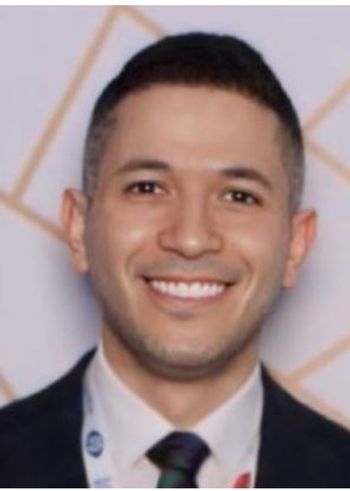
Chronic Pain Syndromes: How to Break the Cycle, Part 2
Establishing the cause of chronic pain is crucial because treatment based on the mechanism of the pain is most likely to be successful.
Establishing the cause of chronic pain is crucial because treatment based on the mechanism of the pain is most likely to be successful. In part 1 of this 2-part article (CONSULTANT, April 1, 2008), we discussed the management of pain associated with knee osteoarthritis. Here we focus on the diagnosis and treatment of trigeminal neuralgia and radicular low back pain.
TRIGEMINAL NEURALGIA
Trigeminal neuralgia presents with sudden, primarily unilateral, brief, stabbing, recurrent pain in the distribution of 1 or more branches of the fifth cranial nerve.1 Although trigeminal neuralgia is the most common cranial nerve neuralgia, the yearly incidence is only about 4 per 100,000, increasing to 20 per 100,000 after the age of 60 years.2 Women are more often affected than men.
Pathophysiology. Trigeminal neuralgia can be classified as primary (idiopathic) or secondary (symptomatic). Underlying processes associated with the secondary form include demyelinating disease, such as multiple sclerosis (often bilateral) or a posterior fossa tumor (eg, meningioma). Studies have suggested that about 10% of patients with trigeminal neuralgia may have a causative intracranial lesion.3
Although there are multiple theories, the exact pathophysiology of trigeminal neuralgia is unknown. One of the current theories supported by ultrastructural analysis is the ignition hypothesis. According to this theory, sensory axons of cranial nerve V become demyelinated in the primary form because of sustained or pulsatile microvascular compression of the trigeminal nerve or ganglia. In the secondary form, demyelination occurs because of compression from a tumor or multiple sclerosis lesion. Once structural damage has occurred to cranial nerve V or its ganglia, ectopic impulse discharges, spontaneous and triggered after discharges, and crossed excitation among neighboring afferent fibers can all lead to pain paroxysms. This could explain why these patients have trigger areas, since electrical activity from A-beta fibers (which respond to light touch) activates nociceptive fibers (C and A-delta fibers).4Diagnosis. In the idiopathic and secondary forms, the attacks are periodic and of short duration, often with lucid intervals. The patient typically describes sharp, shooting, unilateral pain usually in the distribution of the maxillary branch of the fifth cranial nerve (V2) or the mandibular branch (V3). The ophthalmic branch (V1) is involved in fewer than 5% of cases. If V1 is involved, other possible diagnoses, including postherpetic neuralgia, should be excluded. The right cranial nerve V is affected more often than the left; the right to left ratio is 1.5 in the primary form and 2.4 in the secondary.5
Patients often describe activities that bring about symptoms, including chewing, toothbrushing, or hair-brushing, and they often have associated tactile trigger areas. If a patient has pain with swallowing, consider glossopharyngeal nerve neuralgia.1
The secondary form of trigeminal neuralgia typically affects younger persons. Any patient younger than 40 years who has trigeminal neuralgia should undergo a workup for an underlying disease process. In most patients who have the primary form, the results of sensory and motor neurological examinations are normal.
Other diagnoses that can be included in the differential for unilateral facial pain and that must be excluded are:
• Dental pain (eg, pulpitis, fractured tooth, temporomandibular joint disorder, phantom tooth pain).
• Temporal arteritis.
• Carotodynia.
• Cluster headache.
• A cavernous sinus lesion (often a metastatic lesion from the breast, lung, or prostate).
• Postherpetic neuralgia.
A misunderstood cause of facial pain is atypical facial pain syndrome (pain of unknown origin). The diagnosis of atypical facial pain should be made only after all other causes have been ruled out. Unlike patients with trigeminal neuralgia, these patients complain of constant, poorly localized pain often without pain-free intervals or trigger areas. Use of the McGill Pain Questionnaire with close attention to descriptor choice can help distinguish atypical facial pain from trigeminal neuralgia.6 If the history and physical examination suggest either primary or secondary trigeminal neuralgia, additional studies are warranted, including an MRI scan with gadolinium and thin cuts (less than 1 mm) through the trigeminal nerve.7 Particular attention should be paid to the cavernous sinus and Meckel cavity, where the gasserian ganglion is located. The MRI scan can help identify or rule out underlying mass lesions, vascular compression of cranial nerve V, and demyelinating lesions. If multiple sclerosis is suspected, a lumbar puncture can be ordered. Neurophysiological diagnostic testing of the trigeminal reflexes can help differentiate primary (normal reflexes) and secondary trigeminal neuralgia with a sensitivity of 96% and a specificity of 93%.5,8Medical therapy. The first line of treatment for trigeminal neuralgia is medical management. Once the diagnosis has been made and treatment options are being discussed, a resource to which patients can be referred for more information is the Trigeminal Neuralgia Association Web site (
A baseline blood and metabolic profile is needed before drug therapy is started. (
Oxcarbazepine, which is associated with fewer adverse effects, can be used instead of carbamazepine. Start with a dosage of 150 mg PO bid, and increase up to a total daily dose of 600 to 2400 mg/d. The median effective total daily dose of oxcarbazepine for newly diagnosed trigeminal neuralgia is 750 mg (1200 mg for refractory disease). In a small study, lamotrigine was effective in treating refractory trigeminal neuralgia at a maintenance dosage of 400 mg/d.10 Other medications that can be used as a sole agent or in combination with carbamazepine or oxcarbazepine are gabapentin,11 pregabalin,12 tricyclic antidepressants (amitriptyline, nortriptyline), and baclofen.7 Second-generation agents such as pregabalin (dose range, 150 to 600 mg/d) and gabapentin (up to 3600 mg/d) have fewer adverse effects than first-line agents, but they have not been as extensively studied in trigeminal neuralgia. Thus, evidence of their efficacy is based on case reports and extrapolation from other neuropathic pain models.13,14 Opioids are not first-line agents for trigeminal neuralgia, and their use should be restricted to short periods in which rescue medications are needed.
Surgery. About 50% of all patients with trigeminal neuralgia eventually require surgery because of inadequate pain control after multiple medication trials or intolerance of the side effects of drug therapy. Invasive treatments for trigeminal neuralgia include microvascular decompression (MVD), radiofrequency thermal rhizotomy (RTR), and gamma knife radiation (GKR). Although direct comparisons between these treatments have not been conducted, all 3 have been reported to have successful outcomes with different complication profiles.15
Early referral (after less than 8 years of symptoms) may increase the likelihood of a successful surgical outcome with MVD.16 This procedure is performed to relieve vascular compression from cranial nerve V. Barker and associates16 described the results of surgery in 1185 patients and reported a 70% success rate (free of pain without medications) at 10 years.15,16 Major complications associated with the surgery include brain stem damage and ipsilateral hearing loss. This treatment is often recommended for healthy patients who wish to avoid the sensory deficit associated with RTR.
Good to excellent results have been reported for RTR (a less invasive procedure than MVD), with success rates as high as 95% in patients followed up for 15 years.17 Patients who undergo RTR can expect some facial sensory loss, which appears to improve with time. Possible complications are anesthesia dolorosa (pain in an area that lacks sensation) and motor weakness. GKR is the least studied of the 3 techniques, and short- and long-term outcome data are currently being collected.18
Although all these procedures have good safety profiles, they are still associated with the risks of significant morbidity and mortality. Patients with trigeminal neuralgia should be directed to neurosurgeons with extensive training and experience with these procedures.
LUMBAR RADICULAR PAIN
Between 60% and 80% of persons in the United States experience low back pain. As a subset of this group, the number of persons with lumbar radicular symptoms or radiculopathy is much smaller (2% of the population). Of this 2%, about 10% to 25% have persistent radicular symptoms.19
Radiculopathy is associated with objective evidence of sensory and/or motor deficits; only 1% of patients with acute low back pain have radiculopathy.20 Radicular pain in a limb is caused by ectopic activation of nociceptive afferent fibers in the distribution of a spinal nerve. Patients with lumbar radicular pain often describe a constellation of symptoms, including dysesthesias, paresthesias, and hyperalgesia. Sciatica is a general term that covers lower extremity radicular symptoms, usually in an L4, L5, or S1 distribution.
Causes and natural history. Most lumbar radicular pain is initially caused by a herniated nucleus pulposus; the peak incidence occurs between the third and fifth decades. The most susceptible disks in the lumbar region are L5-S1 and L4-5. Currently, 2 mechanisms are believed to cause radicular symptoms associated with a herniated nucleus pulposus: mechanical compression (ie, stimulation of nerve cells and vascular impairment) and a chemical inflammatory cascade initiated by the released nucleus pulposus.21 Segmental demyelination or axon loss may result at the affected nerve root. Another cause of radicular symptoms, lumbar stenosis, will not be discussed in this review.
In most persons who have lumbar radicular pain, the symptoms abate with time. Bush and associates22 examined 165 patients with sciatica whose average duration of symptoms was 4.2 months. These patients were initially treated conservatively with epidural corticosteroids. Eighty-six percent of the patients achieved significant relief with aggressive conservative management (average reduction of pain on the visual analog scale was 94%). A higher percentage of patients with large herniated/sequestered disks had complete resolution of symptoms compared to those with disk bulges. The authors noted that the disk morphology that might be best suited to surgical resection is also the morphology with the greatest likelihood of clinical improvement with conservative management.
A study that used MRI demonstrated that 75% to 100% of herniations described as broad-based protrusions, extrusions, and sequestrations resolved with time. In addition, the associated nerve root compression also improved with time as disks were reabsorbed. Bulges and focal protrusions had the least improvement.23History and physical findings. Listed in
Role of imaging and other diagnostic studies. Because radicular pain resolves with conservative treatment in most patients, routine radiographic imaging is not warranted for at least 4 to 8 weeks from the onset of symptoms. Routine MRI scanning in persons with radicular pain or radiculopathy that is not progressing does not seem to enhance the planning of conservative care or clinical outcomes. A herniated disk may be found on an MRI scan in about 20% to 30% of asymptomatic persons. Moreover, patients who undergo early routine MRI scanning and are aware of the findings may have a lower sense of well-being than those who do not undergo MRI during the acute phase.20 Reserve MRI for patients whose symptoms do not resolve with conservative clinical care and for those who may be potential candidates for surgical intervention. Electrodiagnostic studies (nerve conduction studies and electromyography) can also be useful in determining the cause of lumbar radicular pain.
Treatment. Even though lumbar radicular pain is a significant problem, there are no evidence-based guidelines for its treatment. This is evidenced by the discrepancy in the rate of surgical intervention for lumbar radicular pain in this country compared with others and by regional variations in the United States. For example, in Scandinavia the lifetime prevalence of lumbar disk surgery is 1%, compared with 3% to 4% in the United States.24
Because the natural course of lumbar radicular pain and radiculopathy associated with a herniated nucleus pulposus is generally favorable and symptoms resolve with time in most patients, it is important to determine the optimal conservative and minimally invasive treatments. A cornerstone of treatment should be patient comfort during the time required for natural healing processes. Scientific evidence for many of the conservative treatments used is lacking, however.
Oral medications. Although NSAIDs are often prescribed, there is little evidence to support their efficacy.25 Oral corticosteroids seem to be helpful in patients with a positive straight leg test (pain radiating down the leg with 30 to 70 of hip flexion while supine). The time frame for corticosteroid therapy should be limited because of systemic side effects.
Although anticonvulsants and tricyclic antidepressants are efficacious for many neuropathic pain conditions, including peripheral nerve injury/neuropathy, there are no controlled studies of their use in radicular pain.13,14 In animal models of spinal nerve ligation, amitriptyline and gabapentin have been highly useful in reducing neuropathic pain symptoms, including tactile allodynia.26 Antidepressants with greater noradrenergic activity provide better pain control than those with solely serotonergic activity.27 In patients with refractory symptoms who do not have contraindications, consider a trial of gabapentin and amitriptyline. Amitriptyline may also help normalize sleep patterns.
Opioids can be used for short periods in patients whose pain resists other conservative treatments. Certain opioids are more effective than others for treating neuropathic pain. For example, compared to oxycodone and morphine, methadone had the greatest anti-allodynic potency for both mechanical and cold allodynia in neuropathic pain models.28 Methadone is an antagonist of the N-methyl d-aspartate receptor, which is thought to play a role in the development of central sensitization.
Tramadol, a centrally acting analgesic that binds weakly to the µ-opioid receptor and inhibits norepinephrine and serotonin reuptake, is effective in neuropathic pain conditions.14 Tramadol is a non-scheduled analgesic, and it may be associated with a reduced risk of abuse and physical dependence. Current research is focused on immune mediators that may influence the cytokines released from a herniated nucleus pulposus.
Physical therapy. Physical therapy can reduce pain and limit days off from work by preventing deconditioning. Physical therapists educate patients and assist those who have fear-avoidance behaviors, which can negatively impact outcome.19 Back-specific exercises do not seem to negatively affect the natural course of disk morphology in sciatica.23 Traction is not effective.29
Lumbar epidural steroid injections. Initial research on lumbar epidural steroid injections (LESIs) had mixed results. More recent studies, including those that used fluoroscopic guidance and confirmation with radiographic contrast, demonstrated the efficacy of these injections with extremely low risk.30-32
Disk material evokes a strong chemical inflammation. Corticosteroids help reduce this inflammation and stabilize nerve membranes. Furthermore, by reducing pain, LESIs often allow patients to reduce the dosage of their medication and to participate in activities of daily living while awaiting the natural improvement in symptoms that often occurs in lumbar disk herniation.30
Buttermann33 demonstrated that about 50% of patients randomized to epidural corticosteroid injections after 6 weeks of unsuccessful noninvasive treatment obtained effective pain relief. This group of patients had reductions in their pain and disability scores similar to those of patients who underwent diskectomy. The improvements associated with LESIs lasted the length of follow-up in the study (3 years). Delaying surgical intervention did not seem to negatively affect the likelihood of neurological improvement in patients that crossed over to surgery.33Surgery. Although there has been a trend toward conservative treatment for lumbar disk herniation, in some patients surgery cannot be avoided. Refer a patient to a surgeon immediately if he or she has progressive neurological weakness or signs and symptoms associated with cauda equina syndrome. Patients should also be referred to a surgeon if their symptoms do not abate with conservative treatment and they have a history and physical and imaging findings that suggest lumbar radicular pain. In patients with stable paresis, no significant difference in outcome seems to exist between surgical and nonsurgical treatment.34 These patients can attempt conservative treatment and still hope for improvement in their muscular and sensory deficits. Atlas and colleagues35 found that after 10 years, patients initially treated with surgery had more complete relief of leg pain and improved function and satisfaction compared with nonsurgically treated patients, although improvement in the patient's predominant symptom and work and disability outcomes were the same. In patients who have persistent radicular symptoms after lumbosacral spine surgery, spinal cord stimulation is an effective treatment.3Acknowledgment: The authors thank Dana Dellapiazza, DO, for her editorial and technical assistance.
References:
REFERENCES:
1.
Hentschel K, Capobianco DJ, Dodick DW. Facial pain. Neurologist. 2005;11:244-249.
2.
Manzoni GC, Torelli P. Epidemiology of typical and atypical craniofacial neuralgias. Neurol Sci. 2005;26(suppl 2):S65-S67.
3.
Cheng TM, Cascino TL, Onofrio BM. Comprehensive study of diagnosis and treatment of trigeminal neuralgia secondary to tumors. Neurology. 1993;43:2298-2302.
4.
Devor M, Govrin-Lippmann R, Rappaport ZH. Mechanism of trigeminal neuralgia: an ultrastructural analysis of trigeminal root specimens obtained during microvascular decompression surgery. J Neurosurg. 2002;96:532-543.
5.
Truini A, Galeotti F, Cruccu G. New insight into trigeminal neuralgia. J Headache Pain. 2005;6:237-239.
6.
Melzack R, Terrence C, Fromm G, Amsel R. Trigeminal neuralgia and atypical facial pain: use of the McGill Pain Questionnaire for discrimination and diagnosis. Pain. 1986;27:297-302.
7
. Cohen J. Role of the neurologist in the evaluation and treatment of patients with trigeminal neuralgia. Neurosurg Focus. 2005;18:e2.
8.
Cruccu G, Biasiotta A, Galeotti F, et al. Diagnostic accuracy of trigeminal reflex testing in trigeminal neuralgia. Neurology. 2006;66:139-141.
9.
Wiffen PJ, McQuay HJ, Moore RA. Carbamazepine for acute and chronic pain. Cochrane Database Syst Rev. 2005;(3):CD005451.
10.
Zakrzewska JM, Chaudhry Z, Nurmikko TJ, et al. Lamotrigine (lamictal) in refractory trigeminal neuralgia: results from a double-blind placebo controlled crossover trial. Pain. 1997;73:223-230.
11.
Sist TC, Filadora VA 2nd, Miner M, Lema M. Experience with gabapentin for neuropathic pain in the head and neck: report of ten cases. Reg Anesth. 1997;22:473-478.
12.
Gilron I, Flatters SJ. Gabapentin and pregabalin for the treatment of neuropathic pain: a review of laboratory and clinical evidence. Pain Res Manag. 2006;11(suppl A):16A-29A.
13.
Finnerup NB, Otto M, McQuay HJ, et al. Algorithm for neuropathic pain treatment: an evidence based proposal. Pain. 2005;118:289-305.
14.
Beniczky S, Tajti J, Timea Varga E, VŽcsei L. Evidence-based pharmacological treatment of neuropathic pain syndromes. J Neural Transm. 2005;112:735-749.
15.
Broggi G, Ferroli P, Franzini A, Galosi L. The role of surgery in the treatment of typical and atypical facial pain. Neurol Sci. 2005;26(suppl 2):S95-S100.
16.
Barker FG 2nd, Jannetta PJ, Bissonette DJ, et al. The long-term outcome of microvascular decompression for trigeminal neuralgia. N Engl J Med. 1996;334:1077-1083.
17.
Taha JM, Tew JM Jr, Buncher CR. A prospective 15-year follow up of 154 consecutive patients with trigeminal neuralgia treated by percutaneous stereotactic radiofrequency thermal rhizotomy. J Neurosurg. 1995;83:989-993.
18.
Scrivani SJ. Trigeminal neuralgia. Pain Management Rounds. 2004;1(3) Available at:
http://www.painmanagementrounds.org
. Accessed March 27, 2008.
19.
Awad JN, Moskovich R. Lumbar disc herniations: surgical versus nonsurgical treatment. Clin Orthop Relat Res. 2006;443:183-197.
20.
Modic MT, Obuchowski NA, Ross JS, et al. Acute low back pain and radiculopathy: MR imaging findings and their prognostic role and effect on outcome. Radiology. 2005;237:597-604.
21.
DeLeo JA, Winkelstein BA. Physiology of chronic spinal pain syndromes: from animal models to biomechanics. Spine. 2002;27:2526-2537.
22.
Bush K, Cowan N, Katz DE, Gishen P. The natural history of sciatica associated with disc pathology. A prospective study with clinical and independent radiologic follow-up. Spine. 1992;17:1205-1212.
23.
Jensen TS, Albert HB, Soerensen JS, et al. Natural course of disc morphology in patients with sciatica: an MRI study using a standardized qualitative classification system. Spine. 2006;31:1605-1613.
24.
Garfin SR, Vaccaro AR, eds. Orthopedic Knowledge Update: Spine. Rosemont, Ill: American Academy of Orthopedic Surgeons; 1997.
25.
Vroomen PC, de Krom MC, Slofstra PD, Knottnerus JA. Conservative treatment of sciatica: a systematic review. J Spinal Disord. 2000;13:463-469.
26.
LaBuda CJ, Little PJ. Pharmacological evaluation of the selective spinal nerve ligation model of neuropathic pain in the rat. J Neurosci Methods. 2005;144: 175-181.
27.
Benzon H, Raja SN, Molloy RE, et al, eds. Essentials of Pain Medicine and Regional Anesthesia. 2nd ed. Philadelphia: Elsevier; 2005.
28.
Lemberg K, Kontinen VK, Viljakka K, et al. Morphine, oxycodone, methadone and its enantiomers in different models of nociception in the rat. Anesth Analg. 2006;102:1768-1774.
29.
Clarke J, van Tulder M, Blomberg S, et al. Traction for low back pain with or without sciatica: an updated systematic review within the framework of the Cochrane collaboration. Spine. 2006;31:1591-1599.
30.
McLain RF, Kapural L, Mekhail NA. Epidural steroids for back and leg pain: mechanism of action and efficacy. Cleve Clin J Med. 2004;71:961-970.
31.
DePalma MJ, Bhargava A, Slipman CW. A critical appraisal of the evidence for selective nerve root injection in the treatment of lumbosacral radiculopathy. Arch Phys Med Rehabil. 2005;86:1477-1483.
32.
Weinstein SM, Herring SA; NASS (National American Spine Society). Lumbar epidural steroid injections. Spine J. 2003;3(3 suppl):37S-44S.
33.
Buttermann GR. Treatment of lumbar disc herniation: epidural steroid injection compared with discectomy. A prospective, randomized study. J Bone Joint Surg Am. 2004;86:670-679.
34.
Dubourg G, Rozenberg S, Fautrel B, et al. A pilot study on the recovery from paresis after lumbar disc herniation. Spine. 2002;27:1426-1431.
35.
Atlas SJ, Keller RB, Wu YA, et al. Long-term outcomes of surgical and nonsurgical management of lumbar spinal stenosis: 8 to 10 year results from the maine lumbar spine study. Spine. 2005;30:936-943.
36.
North RB, Kidd DH, Farrokhi F, Piantadosi SA. Spinal cord stimulation versus repeated lumbosacral spine surgery for chronic pain: a randomized, controlled trial. Neurosurgery. 2005;56:98-107.
Newsletter
Enhance your clinical practice with the Patient Care newsletter, offering the latest evidence-based guidelines, diagnostic insights, and treatment strategies for primary care physicians.










































































































































































































































































































